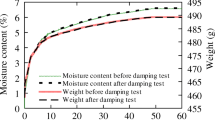Abstract
We measure the P-wave velocity in a clean medium sand subject to very low stress in a large-scale laboratory cross-hole experiment for frequencies less than 10 kHz. In dry sand the velocity is depth-, and therefore, stress-dependent according to a power law. The velocity in partially saturated sand is essentially the same as in dry sand, which confirms the analytical result of the Biot–Gassmann theory. At 100% saturation, the velocity largely exceeds that in dry and partially saturated sand, once again in accordance with the Biot–Gassmann theory. However, the theory under-predicts velocities by up to 12% in some cases at full saturation. The maximum attenuation determined from spectral analysis of the measured signals closely matches the characteristic frequency predicted by the Biot model.













Similar content being viewed by others
Notes
At higher velocities the error will be greater (smaller arrival time for the same data acquisition system resolution). However, for the highest velocities, a “smoothing” interpolation of the recorded waveform using a 3rd order polynomial enabled the error to be kept the same as at lower velocities.
σ′v is calculated assuming a perfectly saturated medium. i.e. \({\gamma^{\prime}=\gamma_{\rm sat}-\gamma_{\rm w}}.\)
This diagram helps to illustrate a point made in the conclusion: High accuracy velocity measurements are needed in order to predict with a meaningful resolution saturations below 99%.
Deaeration of water, use of carbon dioxide gas and application of a back-pressure.
Santamarina points out however that Biot’s characteristic frequency is not necessarily the central frequency of relaxation.
References
Bachrach R, Nur A (1998) High-resolution shallow-seismic experiments in sand, Part 1: water table, fluid flow, and saturation. Geophysics 63(4):1225–1233
Bachrach R, Dvorkin J, Nur A (1998) High-resolution shallow-seismic experiments in sand, Part 2: velocities in shallow unconsolidated sand. Geophysics 63(4):1234–1240
Berill J, Le Kouby A, Canou J, Foray P (2004) The effect of layering on cone resistance: calibration chamber tests. In: 9th Australia New Zealand conference on geomechanics, Auckland
Biot M (1956) Theory of propagation of elastic waves in a fluid-saturated porous solid. I. Low frequency range. J Acoust Soc Am 28(2):168–178
Biot M (1956) Theory of propagation of elastic waves in a fluid-saturated porous solid. II. High frequency range. J Acoust Soc Am 28(2):179–191
Bourbie T, Coussy O, Zinszner B, (1986) Acoustique des milieux continus, Publications de l’Institut Français du Pétrole
Fiorvante V, Jamiolkowski M, Lo Presti D, Manefredini G,Pedroni S (1998) Assessment of the coefficient of the earth pressure at rest from shear wave velocity measurements. Géotechnique 48(5):657–666
Geertsma J, Smit D (1961) Some aspects of elastic wave propagation in fluid-saturated porous solids. Geophysics 26(2):169–181
Hardin B, Richart F (1963) Elastic wave velocities in granular soils. J Soil Mech Found Div Am Soc Civil Eng 89(SM1):33–65
Ishihara K, Tsukamoto Y, Kamada K (2004) Undrained behaviour of near-saturated sand in cyclic and monotonic loading. In: Proceedings of international conference on cyclic behaviour of soils and liquefaction phenomena, Taylor & Francis Group, Bochum, pp 27–39
Iwasaki T, Tsukamoto Y, Kamada K (1977) Shear modulus of sands under cyclic torsional shear loading. J Jpn Soc Soil Mech Found Eng 17(3):19–35
Jaky J (1944) The coefficient of earth pressure at rest. J Soc Hungarian Archit Eng 1:355–358
Kokusho T (2000) Correlation of pore-pressure B-value with P-wave velocity and Poisson’s ratio for imperfectly saturated sand or gravel. Soils Found 40(4):95–102
Roesler S (1979) Anisotropic shear modulus due to stress anisotropy. J Geotech Eng Div 105(7):871–880
Santamarina J (2001) Soils and waves. Wiley, New York
Santamarina J,Cho G (2004) Soil behaviour: the role of particle shape. In: Proceedings of Skempton conference, London
Skempton A (1954) The pore-pressure coefficients A and B. Géotechnique 4(4):143–147
Stoll R (1980) Theoretical aspects of sound transmission in sediments. J Acoust Soc Am 68(5):1341–1349
Tamura S, Tokimatsu K, Abe A, Sato M (2002) Effects of air bubbles on B-value and P-wave velocity of a partly saturated sand. Soils Found 42(1):121–129
Tsukamoto Y, Ishihara K, Nakazawa H, Kamada K, Huang Y (2002) Resistance of partly saturated sand to liquefaction with reference to longitudinal and shear wave velocities. Soils Found 42(6):93–104
Wahyudi I, Montillet A, Khalifa A (2002) Darcy and post-Darcy flows within different sands. J Hydraul Res 40(4):519–525
Yang J (2002) Liquefaction resistance of sand in relation to P-wave velocity. Géotechnique 52(4):295–298
Acknowledgments
The authors would like to thank Fugro France and in particular Alain Puech, project manager of COIMBRA. The COIMBRA project was backed by the Fonds de Soutien des Hydrocarbures. The advice and help of Michel Dietrich (LGIT) is greatly appreciated, as is the assistance of Michel Riondet (LEGI).
Author information
Authors and Affiliations
Corresponding author
Rights and permissions
About this article
Cite this article
Emerson, M., Foray, P. Laboratory P-wave measurements in dry and saturated sand. Acta Geotech. 1, 167–177 (2006). https://doi.org/10.1007/s11440-006-0015-7
Received:
Accepted:
Published:
Issue Date:
DOI: https://doi.org/10.1007/s11440-006-0015-7




